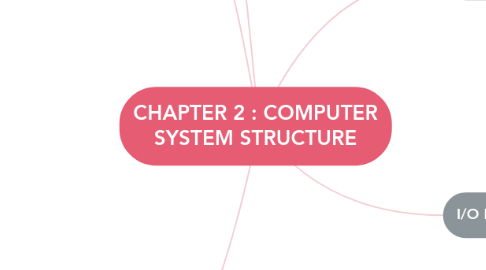
1. Interupt handling
1.1. When CPU is interupt, it stop and immediately transfer execution to a fixed location
1.2. The operating system preserves the state of the CPU by storing registers and the program counter.
1.3. After the interupted is serviced, the saved return address is loaded into the program counter
2. storage hierarchy
2.1. storage systems
2.1.1. speed
2.1.2. cost
2.1.3. volatility
2.2. caching
2.2.1. copying information into faster storage system
2.2.2. Requires a cache management policy
2.2.3. Use of high-speed memory to hold recently-accessed data.
2.2.4. introduces another level in storage hierarchy
3. hardware protection
3.1. dual-mode operation
3.1.1. Sharing system resources requires operating system to ensure that an incorrect program cannot cause other programs to execute incorrectly.
3.1.2. Modes of Operation
3.1.2.1. user mode
3.1.2.2. kernel mode
3.2. I/O protection
3.2.1. All I/O instructions are privileged instructions
3.2.2. Must ensure that a user program could never gain control of the computer in monitor mode
3.3. memory protection
3.3.1. Must provide memory protection at least for the interrupt vector and the interrupt service routines
3.3.2. 2 register are used to determine the range of legal addresses a program may access
3.3.2.1. base register
3.3.2.2. limit register
3.3.3. memory outside the defined range is protected
3.4. CPU protection
3.4.1. Timer – interrupts computer after specified period to ensure operating system maintains control.
3.4.2. Timer is decremented every clock tick. When timer reaches the value 0, an interrupt occurs.
3.4.3. Time also to compute the current time.
3.4.4. Load-timer is a privileged instruction.
4. I/O Methods
4.1. asynchronous I/O Structures
4.1.1. support multiple I/O setting
4.1.2. after I/O starts, control returns to user program without waiting for I/O completion
4.2. synchronous I/O Structures
4.2.1. support one I/O at a time
4.2.2. after I/O starts, control returns to user program only upon I/O completion
5. storage structure
5.1. main memory
5.1.1. only large storage media that the CPU can acess directly
5.2. secondary storage
5.2.1. extension of main memory that provides large nonvolatile storage capacity.

